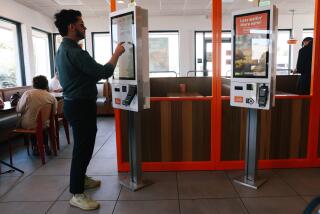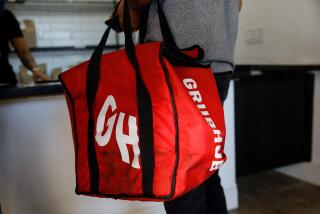Why more restaurants are jumping on the food delivery bandwagon
As restaurant operators struggle to entice more diners to eat out, they are increasingly turning to food delivery as a way to overcome stagnating traffic.
Fueled by the explosion of mobile ordering apps like DoorDash and UberEats, food delivery sales have grown 20 percent over the last five years, while restaurant traffic has flatlined. That’s according to a new study released by the NPD Group, a market research firm that monitored trends in food delivery between 2012 and 2017.
The report’s conclusions reinforce the shifting trends in consumer behavior as the ease of online shopping and meal delivery have taken a bigger bite out of retail sales and eating out at restaurants.
Consumers are simply staying at home more, whether they’re streaming a movie on Netflix instead of heading to a movie theater or supping on a Big Mac and fries on their couches rather than ordering fast food at the drive-through, says NPD’s Warren Solochek.
“So delivery has matured a lot, it used to be the fast food pizza guys and your local Chinese guy and in the past five years there’s been this explosion of delivery opportunity because of the third party aggregators and also because of the demand for restaurants has not really grown so restaurants have had to do something to get people to continue to use their product,” said Solochek, senior vice president of industry relations.
“If I’m not out as much where I would normally stop at a restaurant for a bite to eat, restaurants are having to figure out a way to get their food into the mouths of potential customers, and delivery has become a very important part of the tactics they can use to do that.”
In addition to the 20 percent growth in delivery sales, the NPD study also found that individual orders increased by 10 percent over the five-year period. Although digital ordering is a key factor in the growth of food-service delivery, phone orders still represents nearly half of delivery business, the study found.
In all, delivery over the five-year period accounted for 1.75 billion orders and $16.9 billion in sales, NPD said. And third-party purveyors like GrubHub and Postmates represented 13 percent of delivery traffic.
In San Diego County, both DoorDash and UberEats, which launched here in just the past few years, have seen significant growth. Since the summer of 2015 when it entered the San Diego market, DoorDash’s presence has grown from 500 restaurants to more than 3,500, the company said. Among its restaurant partners is San Diego-based Jack in the Box.
UberEats, which does deliveries for McDonald’s has seen similar growth locally, beginning in 2016 with 100 restaurants and mushrooming to more than 1,000. Last year, the platform said it experienced a more than 150 percent spike in deliveries in San Diego.
Nationwide, its presence has grown to 220 cities in 32 different countries, up markedly since the start of last year when it was operating in just 50 cities, said Derek Beckman, a senior operations manager with UberEats.
Despite restaurants’ increasing appetite for delivery, NPD’s Solochek is not so sure whether the exponential growth is translating into higher profits for operators given the healthy commissions — as much as 30 percent — that the platforms charge. If nothing else, it may prove to be a useful marketing tool for building business, especially among independents who don’t have the resources of a pizza chain, which can do its own delivery, Solochek added.
“So the restaurant has to understand the cost of doing business with one of those aggregators,” he said. “Will I get my name and menu out there and will each of those delivery orders make me money? Some independents may think it’s worth it just to put their menus out there because otherwise people won’t think of me when they make their orders.”
Both DoorDash and UberEats point out that their platforms are introducing consumers to restaurants they might not otherwise have frequented.
“If a restaurant isn’t in your neighborhood you may not venture into that restaurant, so with delivery we’re able to expand a store’s customer base,” said Jessica Lachs, who oversees analytics for DoorDash. “We are also able to market on our platform where we showcase a merchant and highlight newly added restaurants.”
Burger Lounge co-founder J. Dean Loring said the San Diego chain’s partnership with DoorDash has been a profitable one. Its own research revealed it was gaining new customers because of delivery and it was making money on those customers even after the commissions. Burger Lounge delivery is also available on the Postmates platform.
Loring estimates that the share of Burger Lounge’s business from delivery is in the single digits but is significantly higher in some Orange County and Los Angeles-area locations where people are more reluctant to drive to the restaurants.
“Third party delivery in restaurants, I believe, is here to stay so we’ve embraced it. There’s no reason not to and restaurant sales have been challenged over the last two years,” said Loring, whose chain has 23 restaurants, with three more due to open in the coming months. “Also, a large percentage of our delivery happens in off business hours and that’s business that might not otherwise be there.”
The San Diego-based Karina’s chain also uses delivery for its seafood restaurants and still makes money even with the cut that the delivery purveyors take out of restaurant orders, said David Contreras Curiel, a partner in the restaurant group, which also owns Saffron.
“There are people who don’t want to leave home and will order from whatever is available from those platforms so we definitely want to be a part of it,” he said. “I have a friend who is a three-minute drive from Saffron and Karina’s but she’s a doctor and works a crazy schedule, and if we were not on the platform, she would order from somebody else.
“So we are getting something as opposed to nothing.”
Business
lori.weisberg@sduniontribune.com
(619) 293-2251
Twitter: @loriweisberg
More to Read
Inside the business of entertainment
The Wide Shot brings you news, analysis and insights on everything from streaming wars to production — and what it all means for the future.
You may occasionally receive promotional content from the Los Angeles Times.











